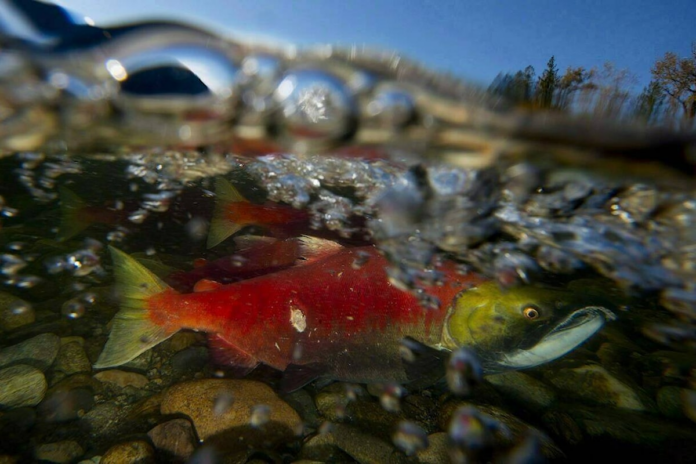Rehabilitation efforts bring spawning salmon back to parts of Metro Vancouver
The metallic screech of a train rolling by. The constant hum of traffic on the nearby Trans-Canada Highway.
These are the sounds of the Brunette River in the fall, as it cuts through the suburbs of Burnaby, B.C.
And rising above the din of Metro Vancouver, the splashing of chum salmon as they push upstream to spawn.
The salmon in the river are looking haggard by mid-November, their skin patchy and worn as they near the end of their lives. But they continue the timeless cycle to produce the next generation of their keystone species.
Jason Hwang, vice-president of the Pacific Salmon Foundation, recalled growing up in Delta, south of Vancouver, and thinking “salmon were something that came into the Fraser River but swam on by the Lower Mainland to better habitat” farther inland.
Then, as a child, Hwang saw salmon spawning in Surrey’s Bear Creek.
“I couldn’t believe it,” he said. “You might look out at the city and Vancouver and say, ‘Well, it’s a big city now and maybe the time to have salmon in our proximity is long passed.’ But that’s not true.”
Efforts to rehabilitate urban waterways have helped bring spawning salmon back to parts of Metro Vancouver, including unlikely-looking streams surrounded by industrial and residential development.
While it’s doubtful that city salmon will recover to their original numbers, those involved in restoration work say it has a host of side benefits, from boosting resilience to flooding to inspiring community connection and stewardship.
Hwang said “an amazing thing happens” when people realize there are important natural assets in their communities, including spawning salmon.
“There’s a pride of stewardship that exists that you see all over the Lower Mainland … in the communities that are aware they’ve got salmon in their neighbourhoods.”
Salmon are a keystone species, supporting the broader ecosystem, and they serve as a barometer for the state of their environment, Hwang said.
“If you look at salmon, it’s one way to get a pretty good picture, and they’re showing us that we can do better, and we need to do better.”
Francisca Olaya Nieto, a biologist with the Vancouver Park Board, said a century of urban development had altered the landscape to the point that aiming for healthy, sustainable salmon populations across the city is probably not realistic.
About 100 kilometres of stream were covered up as Vancouver grew, she said, and just a handful of salmon-bearing waterways continue to flow naturally.
Some of those original streams were diverted into pipes and connected to the city’s water system, while others were filled in, buried and paved over.
Nieto said salmon in urban waterways must contend with pollution, sediment, warming waters, and infrastructure blocking their passage.
Still, they have been returning to streams where the City of Vancouver and its park board have undertaken restoration work, said Nieto, who has been involved in efforts to recover or “daylight” sections of once-buried or degraded waterways.
“The main goal is to find those opportunities where we can improve the water quality, and if salmon can return, that will be a win, but also we can benefit many other species,” she said. “We’re working more toward creating healthy habitat across the city, working toward connectivity and improving our biodiversity.”
Amir Taleghani,asenior engineer with the City of Vancouver, said restoring salmon habitat may have started with naturalization and beautification in mind, but the work also provided an opportunity to tap into the broader benefits of natural assets.
He pointed to Still Creek, flowing from the east side of Vancouver into Burnaby.
The creek has been the site of restoration efforts over several decades, and Taleghani recently captured a video showing salmon spawning in the stream surrounded by parking lots, train tracks, big-box stores and industrial buildings.
But Still Creek plays a role beyond providing salmon habitat, said Taleghani, whose work is focused on floodplains and watercourses in Vancouver.
“Increasingly, we’re seeing the creek as a natural drainage asset, important to … adapting to climate change and managing flood risk,” he said.
“You need room for water to safely be stored in a flood. So, by widening the creek and lowering the surface where we can, we provide the space that in an extreme rainfall event can be flooded in a safe way, but the rest of the year, it can be habitat.”
Taleghani said the city was incorporating Still Creek in its draft land-use plan for the area, which includes two SkyTrain stations, and looking at how the waterway can help manage run-off and flood risk as more housing and infrastructure is built.
Hwang, too, said it was crucial to include natural assets in city and regional planning given the population increases expected for the Lower Mainland.
“As a salmon biologist, I would advocate for all of the reasons that (restoration) can be helpful for salmon, but it’s also helpful for your community,” he said, pointing to flood mitigation as well as recreational opportunities in naturalized areas.
While salmon will likely never return to streams in Metro Vancouver as they once did, Hwang said the target should be to restore as much habitat as possible.
He recalled attending the British Columbia Institute of Technology as a post-secondary student, where there is an ongoing effort to restore a creek that runs through the Burnaby campus and eventually flows into Still Creek.
“Maybe Guichon Creek used to produce thousands of salmon, and now it produces a couple of dozen … but isn’t that still awesome? Isn’t it awesome that in the (school’s) parking lot area, you can make salmon, still, in a stream?”




